Gigabyte Geforce Rtx 2080 Ti Gaming Oc 11g Review
Our Verdict
GeForce RTX 2080 Ti is the fastest gaming graphics bill of fare available, and Gigabyte'due south highest-end air-cooled implementation is big, bold, a flake gaudy, just undeniably fast. Extra display outputs, four years of warranty coverage, an overclocked GPU, and copious RGB LED lighting set this model apart from Nvidia's Founders Edition version.
For
- Infrequent performance
- Extensive use of RGB LEDs complements illuminated PCs
- Four-year warranty coverage
- More than display output options than competing cards
Confronting
- Axial fans exhaust waste material heat into your case
- Cooling solution is louder under load than other Turing-based cards we've tested
- Triple-slot form factor takes up lots of infinite
Tom's Hardware Verdict
GeForce RTX 2080 Ti is the fastest gaming graphics card bachelor, and Gigabyte's highest-end air-cooled implementation is big, bold, a bit gaudy, but undeniably fast. Extra display outputs, four years of warranty coverage, an overclocked GPU, and copious RGB LED lighting set this model autonomously from Nvidia'southward Founders Edition version.
Pros
- +
Exceptional functioning
- +
Extensive use of RGB LEDs complements illuminated PCs
- +
Iv-twelvemonth warranty coverage
- +
More than display output options than competing cards
Cons
- -
Axial fans exhaust waste rut into your example
- -
Cooling solution is louder under load than other Turing-based cards we've tested
- -
Triple-slot form cistron takes up lots of infinite
Gigabyte Aorus GeForce RTX 2080 Ti Xtreme 11G Review
Contend the value of GeForce RTX 2070 versus GTX 1080 all you want. Up where the GeForce RTX 2080 Ti lives, there is no competition. At that place is no point to arguing whether $i,200/£1,100 (or more) is worth paying. If you want polish performance at 3840 x 2160 with detail settings cranked upward, GeForce RTX 2080 Ti is the only game in town. Really, the one conclusion you face is spending big money on Nvidia'southward Founders Edition version or springing for an even more than expensive third-party model with a larger cooler, fancy lighting, and a longer warranty.

Gigabyte's Aorus GeForce RTX 2080 Ti Xtreme 11G epitomizes the superlative end of an already flagship-course graphics menu. It takes Nvidia's specifications and kicks them up a notch. Mayhap it's fitting, then, that such an exclusive piece of hardware is also, in fact, quite rare. Months after its official introduction the Aorus GeForce RTX 2080 Ti Xtreme 11G remains difficult to find. But that's not going to stop the states from running the board through our gauntlet of functioning, ability, and thermal benchmarks.
Meet the Aorus GeForce RTX 2080 Ti Xtreme 11G
Gigabyte doesn't publish a specification for the Xtreme 11G's ability consumption. However, our sensors signal that this GeForce RTX 2080 Ti uses up to ~300W between the PCIe slot and a pair of eight-pin auxiliary connectors. That's a total 40W more than than Nvidia's Founders Edition card, and roughly the aforementioned equally a Radeon RX Vega 64.
Coping with big power consumption requires a capable thermal solution. Gigabyte tops the TU102 processor with a substantially-sized heat sink and three 100mm fans to keep Nvidia'southward GPU absurd. As a effect, the GeForce RTX 2080 Ti Xtreme 11G is both large and heavy. According to our scale, it weighs almost iii lbs. (1,351g), making this the beefiest GeForce RTX 20-serial carte we've tested.
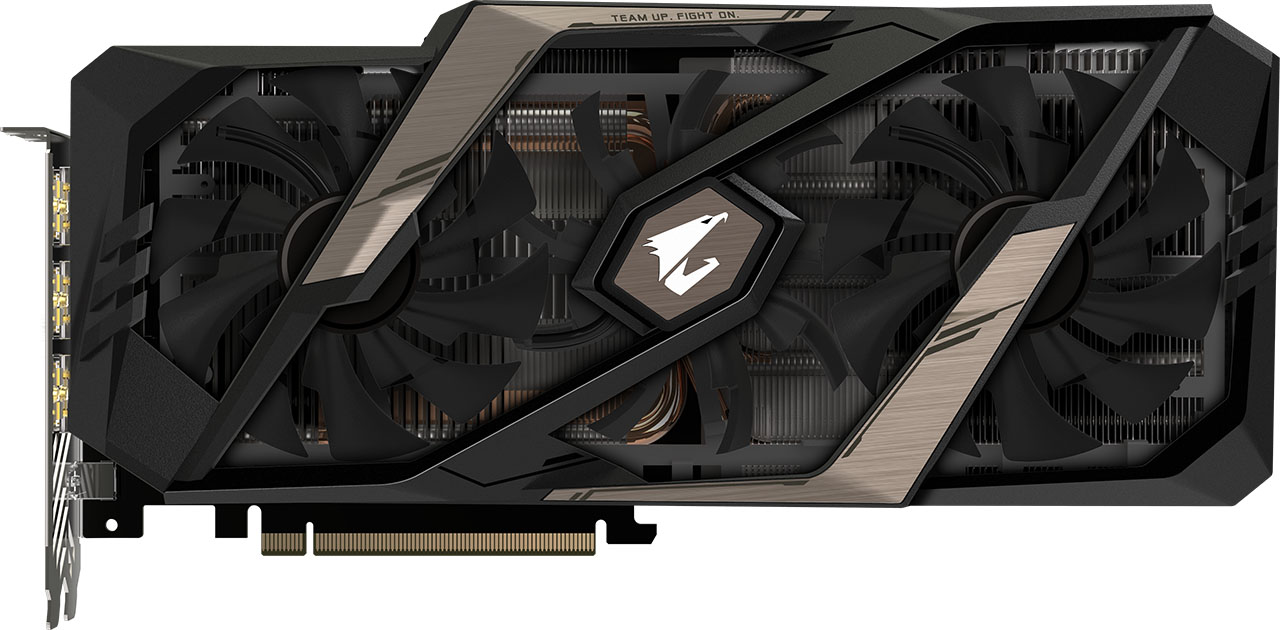
Information technology isn't the longest, though. Considering Gigabyte's fan shroud does not overhang the PCB, an xi ¼" (28.6cm) measurement fits meliorate than cards like Asus' ROG Strix GeForce RTX 2070 O8G Gaming when case clearance is an effect. Height is another matter entirely. In order to arrange those fans, Gigabyte needed to employ an especially tall shroud. So, from the bottom of its PCIe connector to the card's top edge, y'all're looking at roughly five ¼" (13.4cm). Depth might be an issue if y'all're short on expansion slots. There are no 2.v-slot pretenses—this is a full three-slot carte occupying 2 ⅜" (60mm) of infinite from the backplate to the widest part of its shroud.
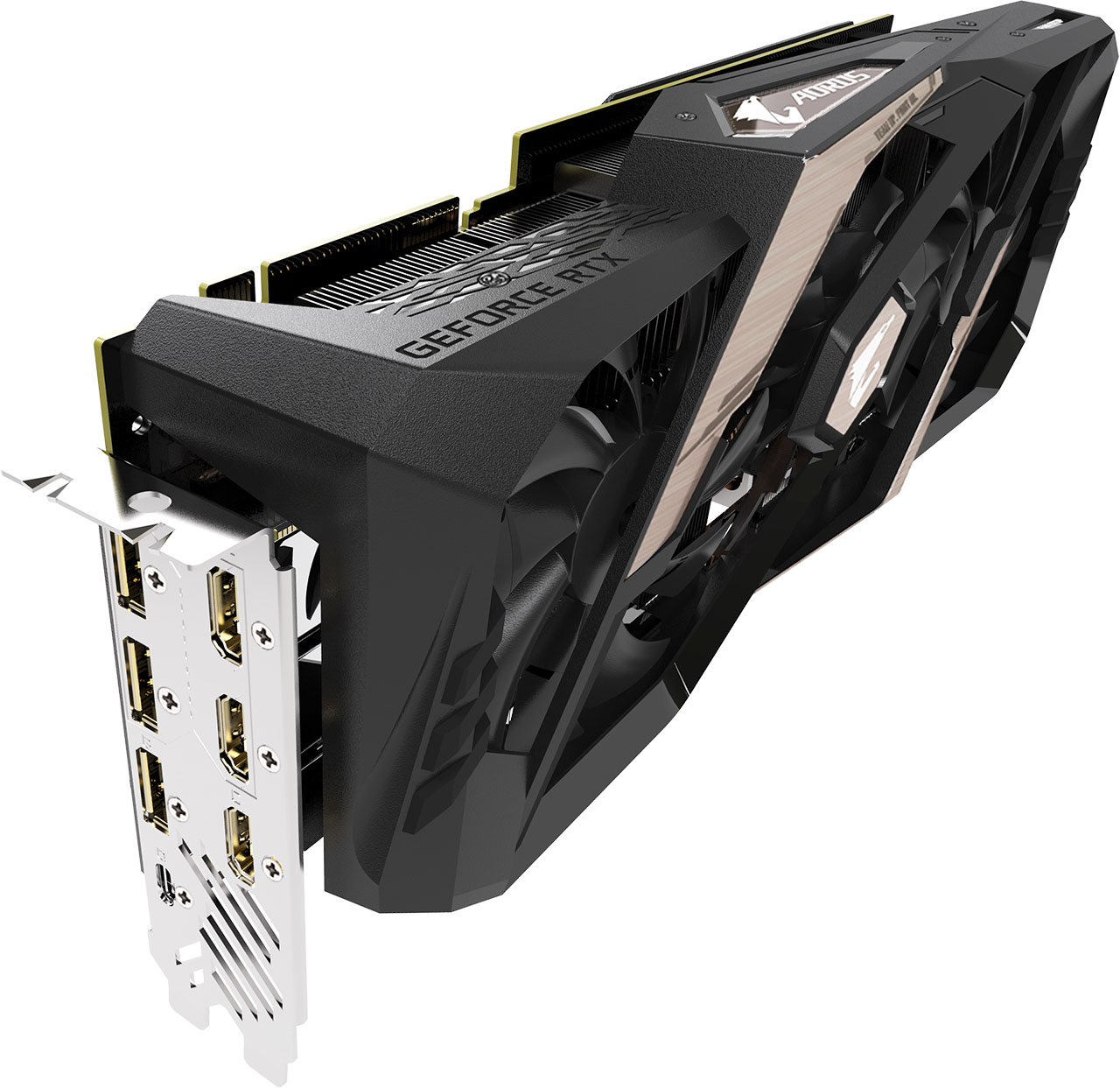
The menu's thickness is pretty evenly separate between its rut sink and fan shroud. Predominately matte black plastic is accented past silver swoops and sleeky black edges. Underneath the decorative embrace, three 100mm fans in a stacked configuration overlap each other across the libation'southward length. Past overlapping and spinning in opposite directions, Gigabyte claims its Windforce Stack 3X system yields complementary airflow from each of the fans, rather than inefficient turbulence. Interestingly, though, based on Gigabyte's own diagrams and experiments, the center and right fans blow down onto your motherboard, while the left and middle fans push button air out the carte'due south peak—right up against an overhang in the shroud.
The heat sink is split into two similarly-sized sections, each shaped differently to accommodate surface-mounted components below them. In the center, fins are cut to the same height, maximizing surface area. Only the outer ii-thirds of both sinks employ an athwart fin blueprint, with every other fin sitting lower. Gigabyte says this helps channel air through the fins while reducing noise.

The heat sink one-half closest to the display outputs sits on top of Nvidia's TU102 processor. 7 rut pipes brand directly contact with the GPU die. Ii of them curve dorsum in to the sink'south top and bottom edges, ensuring thermal energy is prodigal evenly. Meanwhile, five pipes pass into the other sink, running all the manner through to its far border. A spacer under the GPU sink sandwiches thermal pads between itself and GDDR6 memory modules surrounding TU102. Both sides also contact voltage regulation circuitry on the board to alleviate hot spots.
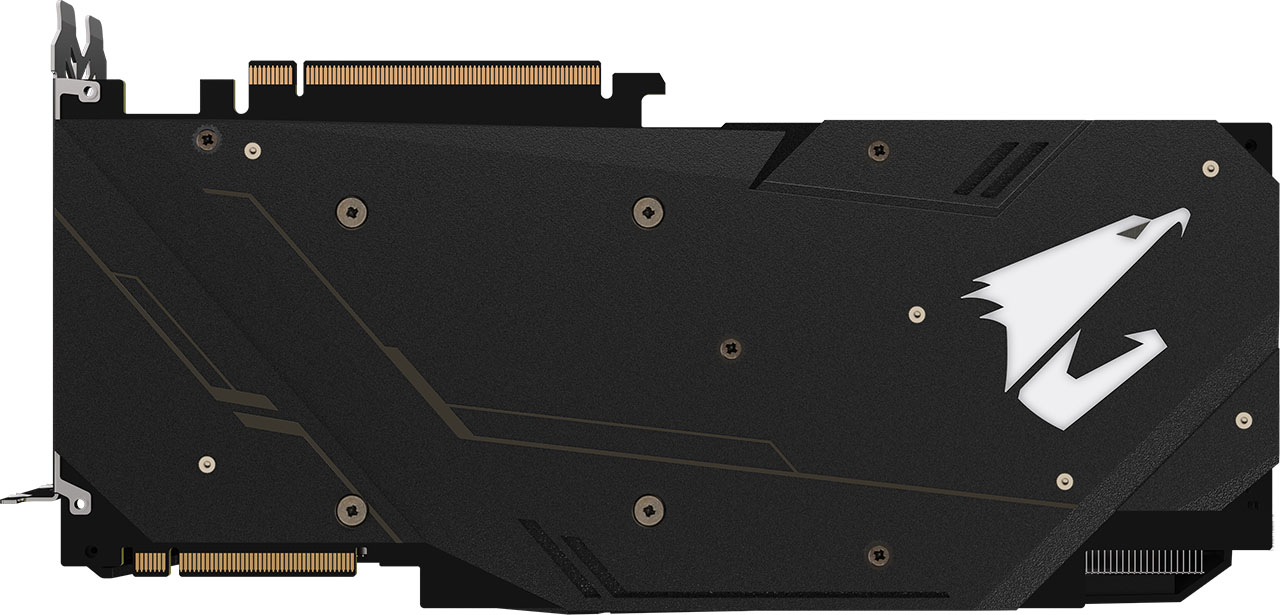
Rather than building its thermal solution onto a metal frame close to the GeForce RTX 2080 Ti Xtreme 11G's PCB, Gigabyte'south backplate bolts directly to the heat sink in 10 places. A metal frame on top of the sink adds rigidity by keeping the thermal solution from flexing. Fifty-fifty then, this is an extremely heavy card to hang from a PCIe slot, so Gigabyte bundles a stand meant to support the card by pushing upwardly from your bottom-mounted PSU or the floor of your chassis.
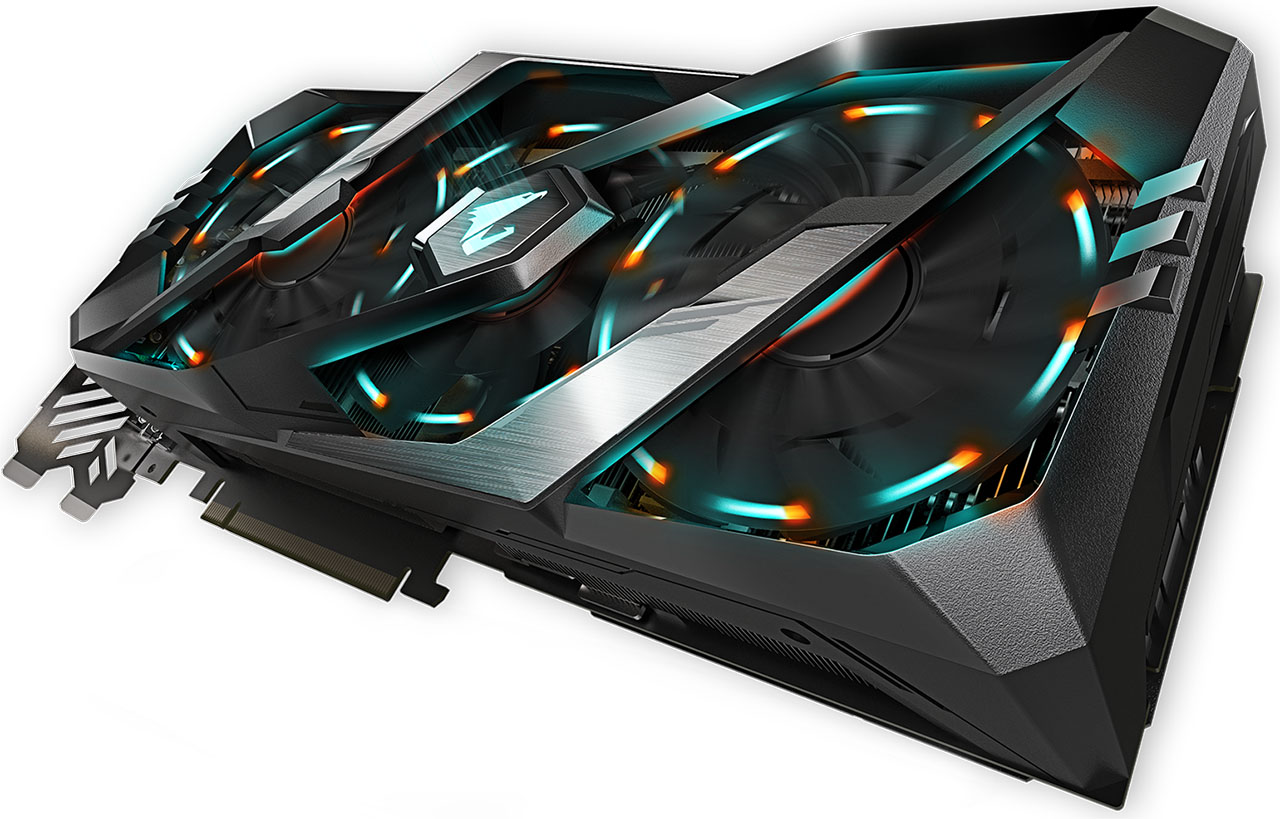
Across souped-upwards cooling, lighting is also a major component of this card'due south Aorus Xtreme branding. RGB LEDs higher up each fan shine down onto a unmarried piping that takes the light out onto ane fan blade. Gigabyte's RGB Fusion 2.0 software allows you to control the effects those LEDs create, from shine pulses and gradients to more jarring strobes and flashes. Backlit Aorus logos on the board's meridian and back are synchronized to the fans, ensuring your scheme of choice is visible from whatsoever bending.
Gigabyte does enable a semi-passive mode called 3D Agile Fan, which keeps the fans from spinning during idle periods. Merely exist enlightened that turning this feature on turns off the fan LEDs, leaving y'all with illuminated logos and a Fan Terminate indicator along the summit edge.

Simply to a higher place the Fan Cease indicator is a pair of 8-pin power connectors rotated 180 degrees to avoid hanging up on the heat sink underneath them. LEDs but above each connector aid diagnose power supply issues. When they're off, everything'due south good. If you forget to run a cable from your PSU, they light up. Or, if power is intermittent, they blink to betoken an abnormality. At the other end of the meridian border, an NVLink interface is protected past an orange plastic slice. The integrated cover on Nvidia'southward Founders Edition card is definitely classier-looking.
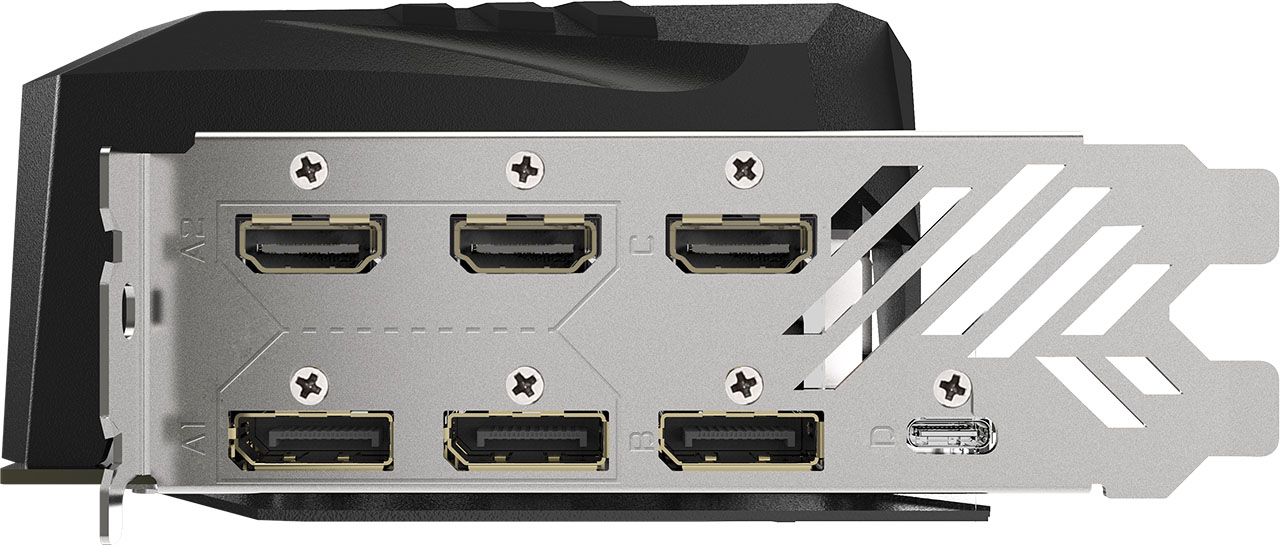
Considering the heat sink's fins move air upwardly and downwards, there is no need for ventilation on the expansion bracket. Gigabyte instead fills its two-slot cover with seven display outputs: 3 DisplayPort connectors, three HDMI ports, and one USB Type-C interface. Of form, TU102 can just drive four displays simultaneously, so the seven connectors must be utilized via two distinct modes. At any given time, either two HDMI ports or two DP interfaces are turned off. Kudos to Gigabyte, though, for giving gamers gobs of connectivity, saving them from the annoying adapters.

A metal backplate gives the ii heat sink pieces something solid to screw into. Information technology as well hosts the Aorus logo, which is backlit and controllable through Gigabyte's RGB Fusion two.0 software. The plate is solid, covering the PCB from finish to end. There are no ventilation holes for trapped heat to escape from. However, pads behind the GPU do describe thermal energy away from TU102.
| Aorus GeForce RTX 2080 Ti Xtreme 11G | GeForce RTX 2080 Ti Iron | GeForce RTX 2080 FE | GeForce GTX 1080 Ti FE | |
| Architecture (GPU) | Turing (TU102) | Turing (TU102) | Turing (TU104) | Pascal (GP102) |
| CUDA Cores | 4352 | 4352 | 2944 | 3584 |
| Peak FP32 Compute | xv.four TFLOPS | fourteen.2 TFLOPS | 10.6 TFLOPS | 11.iii TFLOPS |
| Tensor Cores | 544 | 544 | 368 | N/A |
| RT Cores | 68 | 68 | 46 | N/A |
| Texture Units | 272 | 272 | 184 | 224 |
| Base of operations Clock Rate | 1350 MHz | 1350 MHz | 1515 MHz | 1480 MHz |
| GPU Boost Rate | 1770 MHz | 1635 MHz | 1800 MHz | 1582 MHz |
| Memory Capacity | 11GB GDDR6 | 11GB GDDR6 | 8GB GDDR6 | 11GB GDDR5X |
| Retentivity Motorbus | 352-flake | 352-bit | 256-bit | 352-bit |
| Memory Bandwidth | 616 GB/s | 616 GB/s | 448 GB/s | 484 GB/s |
| ROPs | 88 | 88 | 64 | 88 |
| L2 Enshroud | 5.5MB | 5.5MB | 4MB | 2.75MB |
| TDP | 300W | 260W | 225W | 250W |
| Transistor Count | eighteen.6 billion | eighteen.6 billion | 13.6 billion | 12 billion |
| Dice Size | 754 mm² | 754 mm² | 545 mm² | 471 mm² |
| SLI Support | Aye (x8 NVLink, x2) | Yes (x8 NVLink, x2) | Yep (x8 NVLink) | Yes (MIO) |
What lives under the Aorus GeForce RTX 2080 Ti Xtreme 11G'due south hood is already well-known. Nosotros dug deep into the TU102 graphics processor and its underlying compages in Nvidia's Turing Architecture Explored: Inside the GeForce RTX 2080. Gigabyte takes the same graphics processor with iv,352 of its CUDA cores enabled and bumps the typical GPU Boost rating up to 1,770 MHz (versus the Founders Edition card'southward one,635 MHz and the reference ane,545 MHz).
The Gigabyte bill of fare's 11GB of GDDR6 memory moves data at fourteen Gb/s, matching Nvidia's reference blueprint. Despite their similarities, though, this overclocked model is consistently faster than the smaller, cheaper Founders Edition model.
Most of Gigabyte's graphics cards include three years of warranty coverage. Sure SKUs, however, come with an optional four-year guarantee later on online registration in the first xxx days of ownership. The Aorus GeForce RTX 2080 Ti Xtreme 11G is i such production, giving it a definite advantage over competing cards without that actress bit of protection.
How Nosotros Tested Gigabyte's Aorus GeForce RTX 2080 Ti Xtreme 11G
Gigabyte'south latest will no doubt be found in one of the many high-end CPU/motherboard platforms now bachelor from AMD and Intel. Our graphics station still employs an MSI Z170 Gaming M7 motherboard with an Intel Core i7-7700K CPU at 4.2 GHz, though. The processor is complemented by G.Skill's F4-3000C15Q-16GRR retentivity kit. Crucial's MX200 SSD remains, joined by a one.4TB Intel DC P3700 loaded down with games. Special thank you go to Noctua for sending over a batch of NH-D15S coolers. These top our graphics testing platform, our special power consumption measurement rig, and the organisation we use for testing temperature/fan speed in a closed example.
As far as competition goes, the Aorus GeForce RTX 2080 Ti Xtreme 11G is really in a league of its own, competing against other GeForce RTX 2080 Ti cards, Titan RTX, and Titan V. Nosotros include all of those in our performance benchmarks, forth with GeForce RTX 2080, GeForce RTX 2070, GeForce GTX 1080 Ti, Titan Ten, GeForce GTX 1070 Ti, and GeForce GTX 1070 from Nvidia. AMD is represented past the Radeon RX Vega 64 and Radeon RX Vega 56. All of the comparison cards are either Founders Edition or reference models.
Our list of benchmarks received some attention alee of today's review. It now includesAshes of the Singularity: Escalation,Battlefield V,Destiny 2, Far Weep v, Forza Motorsport 7, Yard Theft Auto V,Metro: Concluding Light Redux,Rise of the Tomb Raider,Tom Clancy's The Partitioning,Tom Clancy's Ghost Recon Wildlands,The Witcher 3, and Wolfenstein II: The New Colossus.
The testing methodology we're using comes from PresentMon: Operation In DirectX, OpenGL and Vulkan. In short, these games are evaluated using a combination of OCAT and our ain in-house GUI for PresentMon, with logging via GPU-Z.
As we generate new information, nosotros're using new drivers. For Nvidia, that means testing the 2 new games with build 417.22 (all of the Gigabyte card'southward numbers are generated with that driver, likewise). The Founders Edition cards are tested with 416.33 (2070) and 411.51 (2080 and 2080 Ti). Older Pascal-based boards are tested with build 398.82. Titan 5's results were spot-checked with 411.51 to ensure performance didn't change. AMD's cards utilize Ruby Adrenalin Edition 18.8.1 (except for theBattlefield VandWolfensteintests, which are tested with Adrenalin Edition 18.11.ii).
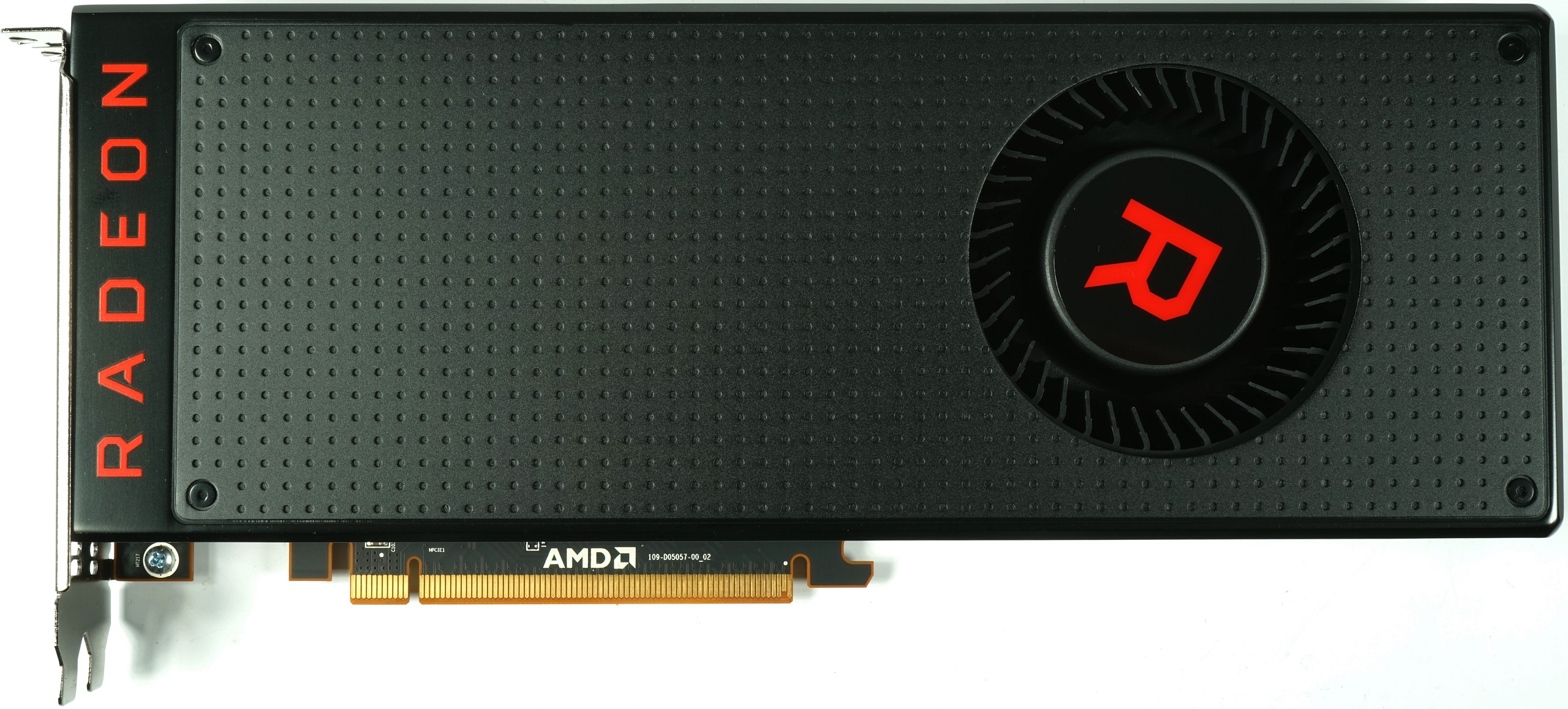
AMD Radeon Vega RX 56 8GB

AMD Radeon Vega RX 64 8GB

NVIDIA GeForce Titan X Pascal 12GB
MORE: Best Graphics Cards
More than: Desktop GPU Performance Hierarchy Table
More: All Graphics Content
Source: https://www.tomshardware.com/reviews/gigabyte-aorus-geforce-rtx-2080-ti-xtreme-11g,5953.html
0 Response to "Gigabyte Geforce Rtx 2080 Ti Gaming Oc 11g Review"
Post a Comment